Decomposing Carbon Intensity Trends in China’s Civil Aviation: A Comprehensive Analysis from 1998 to 2019
Abstract
:1. Introduction
2. Methodology
2.1. Estimation Model of CO2 Emissions Intensity of China’s Civil Aviation
- represents the CO2 emission intensity in year for the China civil aviation sector.
- denotes the total CO2 emissions in year for the China civil aviation sector.
- signifies the total air transport revenue for the China civil aviation sector.
- is the annual fuel consumption for China’s civil aviation sector.
- is the emission factor of CO2 for fuel, based on the assumption that the mean molecular formula of aviation fuel (C12H23) results in the production of 3.15 kg of CO2 per kg of fuel consumed.
2.2. Integrated Decomposition Model for Carbon Intensity
- : Carbon emissions per unit of air operating revenue, providing a metric for assessing the environmental efficiency of aviation operations.
- : Carbon emissions per revenue ton–kilometers, offering a direct measure of emissions relative to air transport operation.
- : Load factor, indicating the utilization efficiency of average aircraft capacity.
- : The average available capacity per flight, which influences fuel consumption and, consequently, carbon emissions.
- : The average transport distance (km), reflecting the operational range and its impact on carbon emissions.
- : The average flights operated by aircraft, reflecting the operational utilization of the aircraft.
- : The ratio of the total number of aircraft to the total operation cost, indicating the cost efficiency of the fleet.
- The ratio of total operation cost to total operation revenue, which reflects the financial efficiency of aviation operations.
3. Empirical Study
3.1. Data Collection
3.2. Temporal Distribution Characteristics of CO2 Intensity of China’s Civil Aviation
3.3. Decomposition Analysis of CO2 Emissions per Unit of Air Transport Revenue
4. Policy Implication
5. Conclusions
Author Contributions
Funding
Data Availability Statement
Conflicts of Interest
References
- International Energy Agency (IEA). Energy Technology Perspectives 2020. 2020. Available online: https://iea.blob.core.windows.net/assets/7f8aed40-89af-4348-be19-c8a67df0b9ea/Energy_Technology_Perspectives_2020_PDF.pdf (accessed on 3 January 2024).
- Climate Action Tracker. International Shipping and Aviation Emissions Goals Both “Critically Insufficient”. 2020. Available online: https://climateactiontracker.org/documents/711/CAT_bunkers_webinar_20200625_ZrdXKAf.pdf (accessed on 3 January 2024).
- International Civil Aviation Organization. Resolution A41-22: Consolidated Statement of Continuing ICAO Policies and Practices Related to Environmental Protection—Carbon Offsetting and Reduction Scheme for International Aviation (CORSIA). 2016. Available online: https://www.icao.int/environmental-protection/CORSIA/Documents/Resolution_A41-22_CORSIA.pdf (accessed on 3 January 2024).
- International Civil Aviation Organization. Resolution A41-21: Consolidated Statement of Continuing ICAO Policies and Practices Related to Environmental Protection—Climate Change. 2022. Available online: https://www.icao.int/environmental-protection/Documents/Assembly/Resolution_A41-21_Climate_change.pdf (accessed on 30 January 2024).
- Lee, B.; Worthington, A. Technical efficiency of mainstream airlines and low-cost carriers: New evidence using bootstrap data envelopment analysis truncated regression. J. Air Transp. Manag. 2014, 38, 15–20. [Google Scholar] [CrossRef]
- Yue, X.; Byrne, J. Linking the determinants of air passenger flows and aviation-related carbon emissions: A European study. Sustainability 2021, 13, 7574. [Google Scholar] [CrossRef]
- Zhou, P.; Ang, B.W.; Poh, K.L. A Survey of Data Envelopment Analysis in Energy and Environmental Studies. Eur. J. Oper. Res. 2008, 189, 1–18. [Google Scholar] [CrossRef]
- Li, Y.; Wang, Y.; Cui, Q. Evaluating airline efficiency: An application of virtual frontier network SBM. Transp. Res. Part E Logist. Transp. Rev. 2015, 81, 1–17. [Google Scholar] [CrossRef]
- Kwan, I.; Rutherford, D. Assessment of U.S. domestic airline fuel efficiency since 2010. Transp. Res. Rec. J. Transp. Res. Board 2015, 2501, 1–8. [Google Scholar] [CrossRef]
- Kim, H.; Son, J. Analyzing the environmental efficiency of global airlines by continent for sustainability. Sustainability 2021, 13, 1571. [Google Scholar] [CrossRef]
- Cui, Q. Airline energy efficiency measures using a network range-adjusted measure with unified natural and managerial disposability. Energy Effic. 2020, 13, 1195–1211. [Google Scholar] [CrossRef]
- Chen, Y.; Li, L.; Yu, J.; Tsai, S.; Wang, J. An empirical study on environmental efficiency measurements and influencing factors. Ecol. Chem. Eng. S 2020, 27, 543–553. [Google Scholar] [CrossRef]
- Cai, B.; Yang, W.; Cao, D.; Liu, L.; Zhou, Y.; Zhang, Z. Estimates of China’s national and regional transport sector CO2 emissions in 2007. Energy Policy 2012, 41, 474–483. [Google Scholar] [CrossRef]
- Kaya, Y. Impact of Carbon Dioxide Emission Control on GNP Growth: Interpretation of Proposed Scenarios; IPCC Energy and Industry Subgroup, Response Strategies Working Group: Paris, France, 1989. [Google Scholar]
- Pui, K.L.; Othman, J. The influence of economic, technical, and social aspects on energy-associated CO2 emissions in Malaysia: An extended Kaya identity approach. Energy 2019, 181, 468–493. [Google Scholar] [CrossRef]
- Yang, J.; Cai, W.; Ma, M.; Li, L.; Liu, C.; Ma, X.; Chen, X. Driving forces of China’s CO2 emissions from energy consumption based on Kaya-LMDI methods. Sci. Total Environ. 2020, 711, 134569. [Google Scholar] [CrossRef] [PubMed]
- Ang, B.W. The LMDI approach to decomposition analysis: A practical guide. Energy Policy 2005, 33, 867–871. [Google Scholar] [CrossRef]
- Li, J.; Zeng, T. Analysis on Yunnan Carbon Emission Factors Based on Kaya Identity. Sci. Technol. Manag. Res. 2016, 36, 260–266. [Google Scholar] [CrossRef]
- International Civil Aviation Organization. Presentation of 2020 Air Transport Statistical Results. 2020. Available online: https://www.icao.int/annual-report-2020/Documents/ARC_2020_Air%20Transport%20Statistics_final_sched.pdf (accessed on 30 January 2024).
- International Air Transport Association. Air Passenger Numbers to Recover in 2024. 2022. Available online: https://www.iata.org/contentassets/0276e81943f34f12b515bf84eb42b60b/2022-03-01-01-cn.pdf (accessed on 30 January 2024).
- Morrell, P. The potential for European aviation CO2 emissions reduction through the use of larger jet aircraft. J. Air Transp. Manag. 2009, 15, 151–157. [Google Scholar] [CrossRef]
- Liu, X.; Hang, Y.; Wang, Q.; Zhou, D. Drivers of civil aviation carbon emission change: A two-stage efficiency-oriented decomposition approach. Transp. Res. Part D Transp. Environ. 2020, 89, 102612. [Google Scholar] [CrossRef]
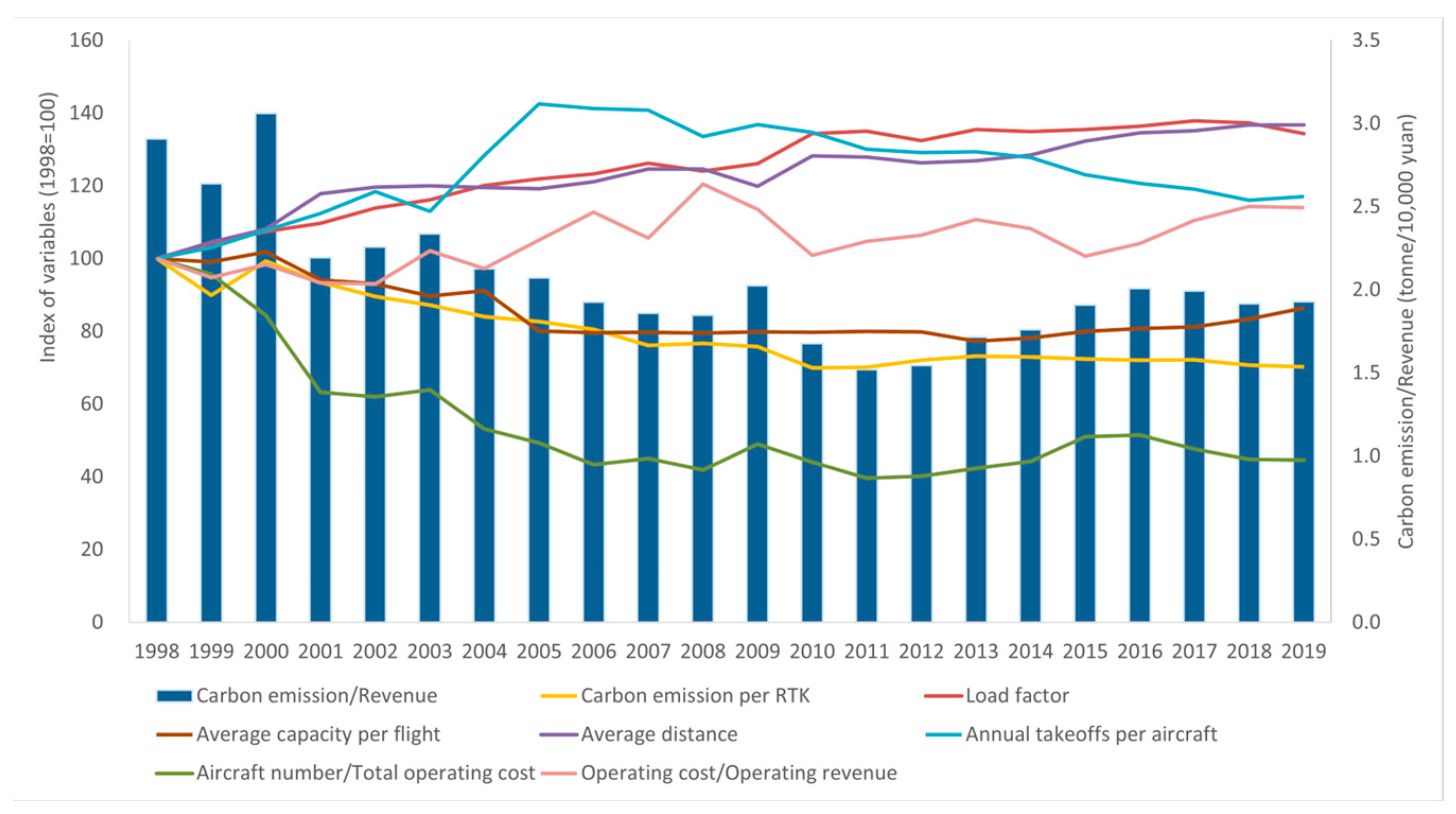



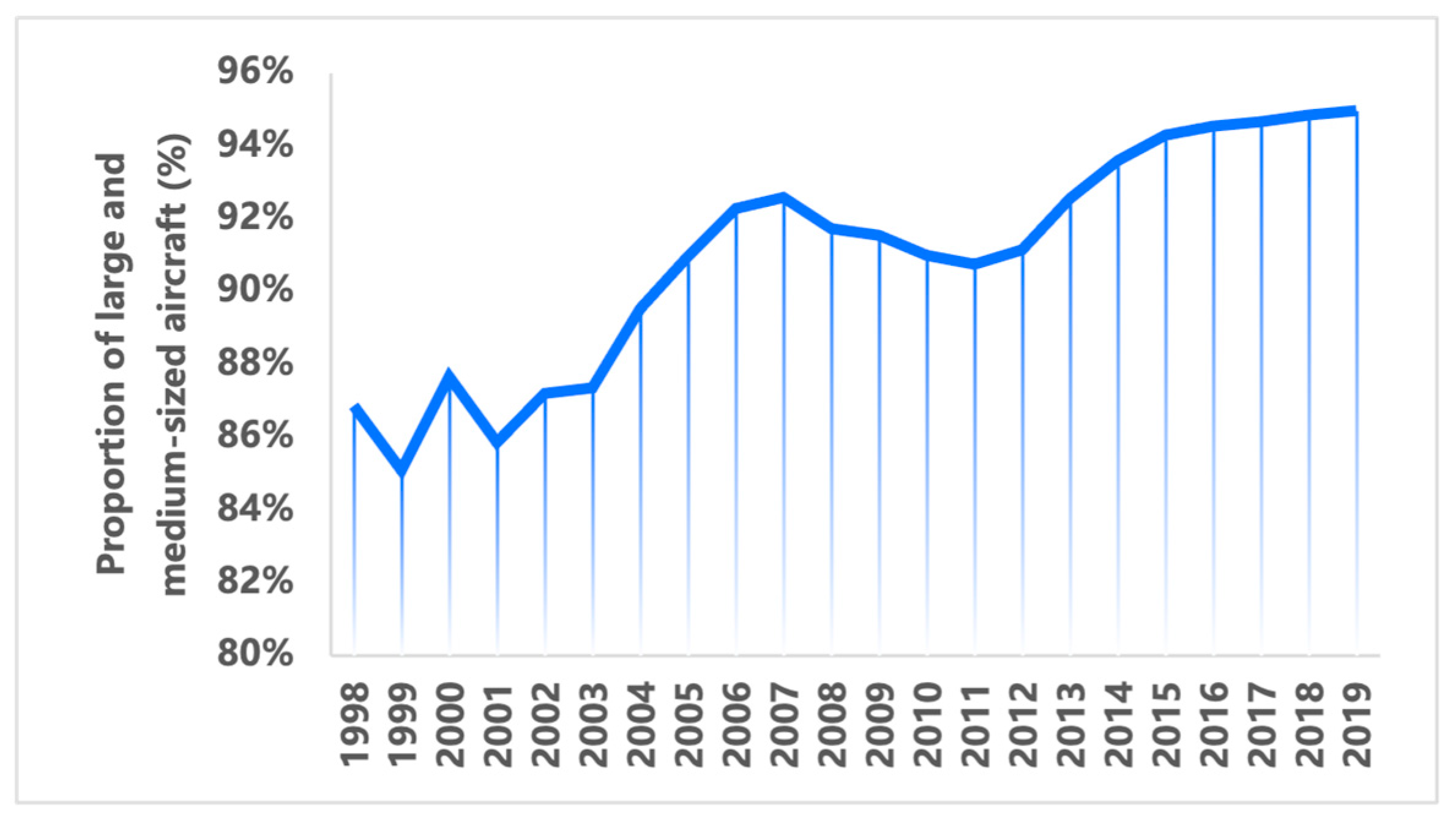
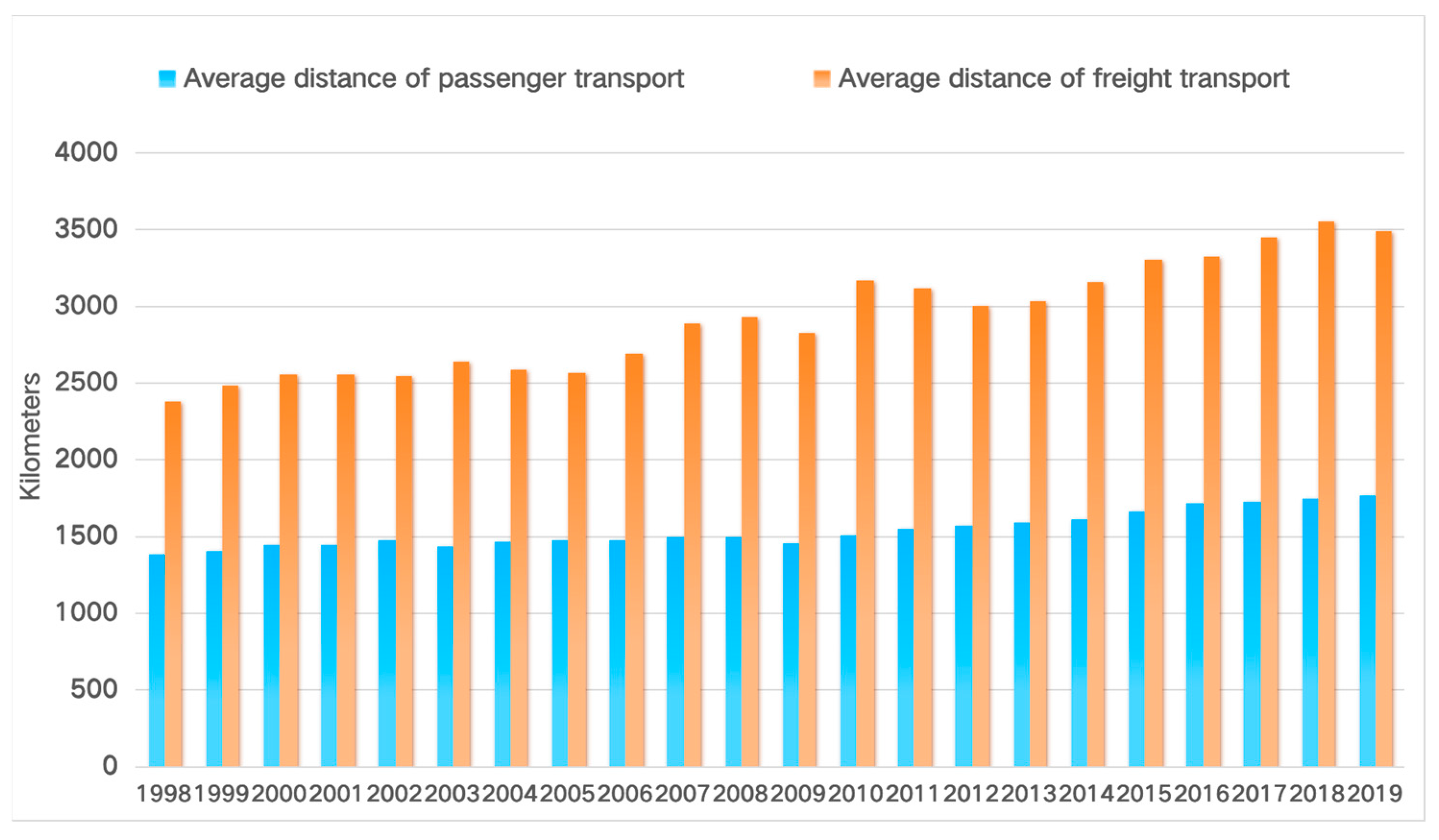
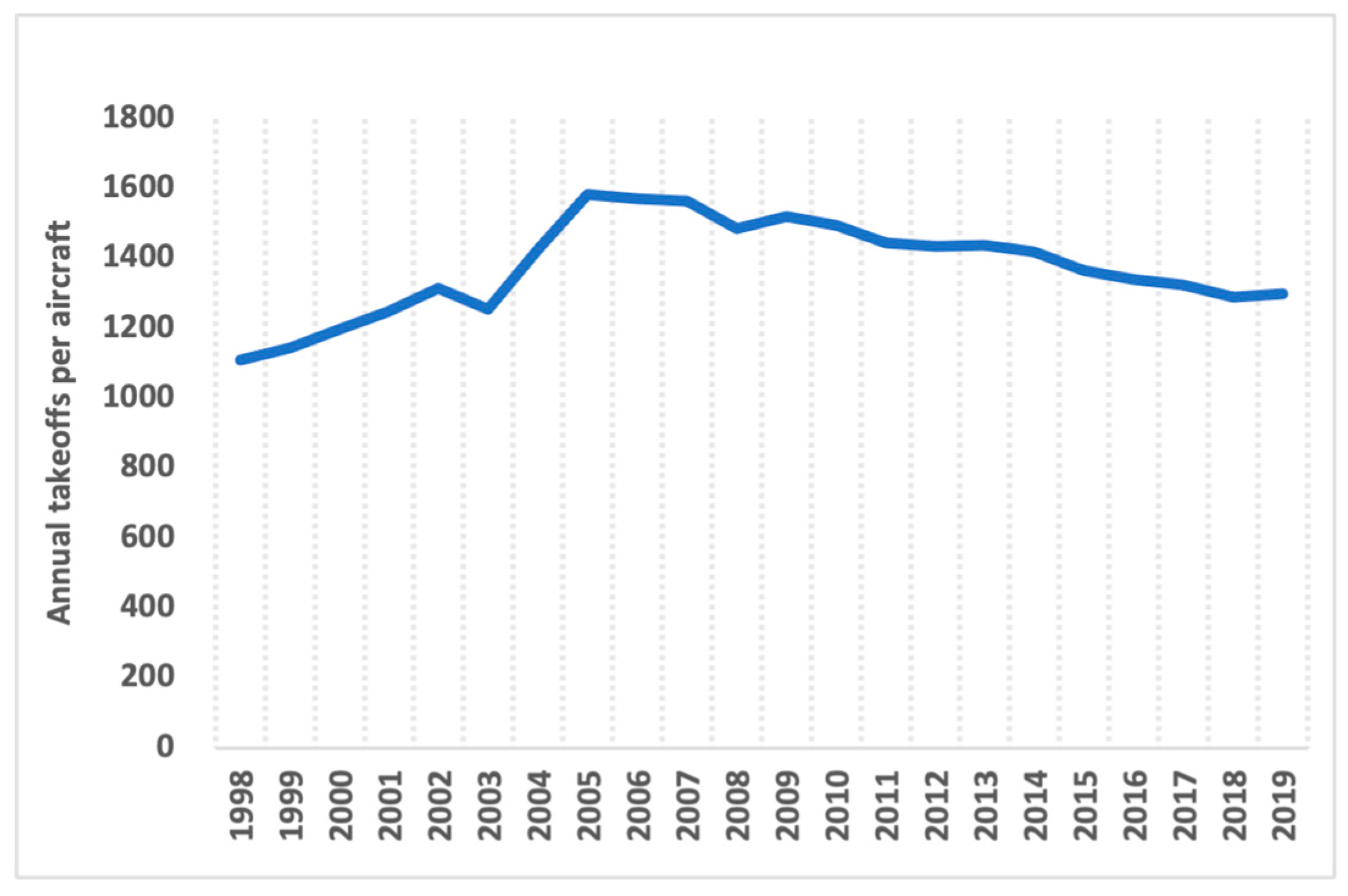
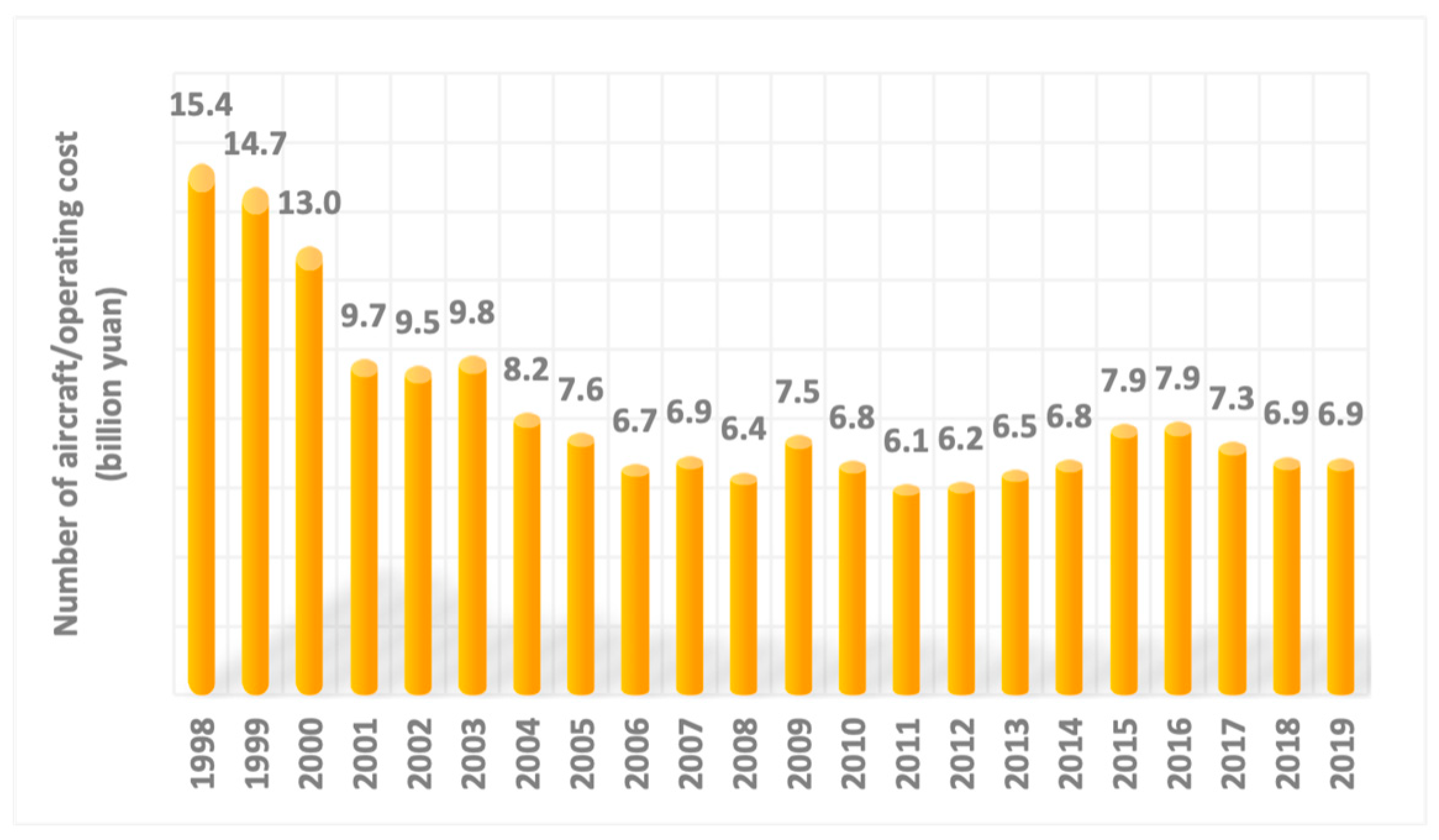
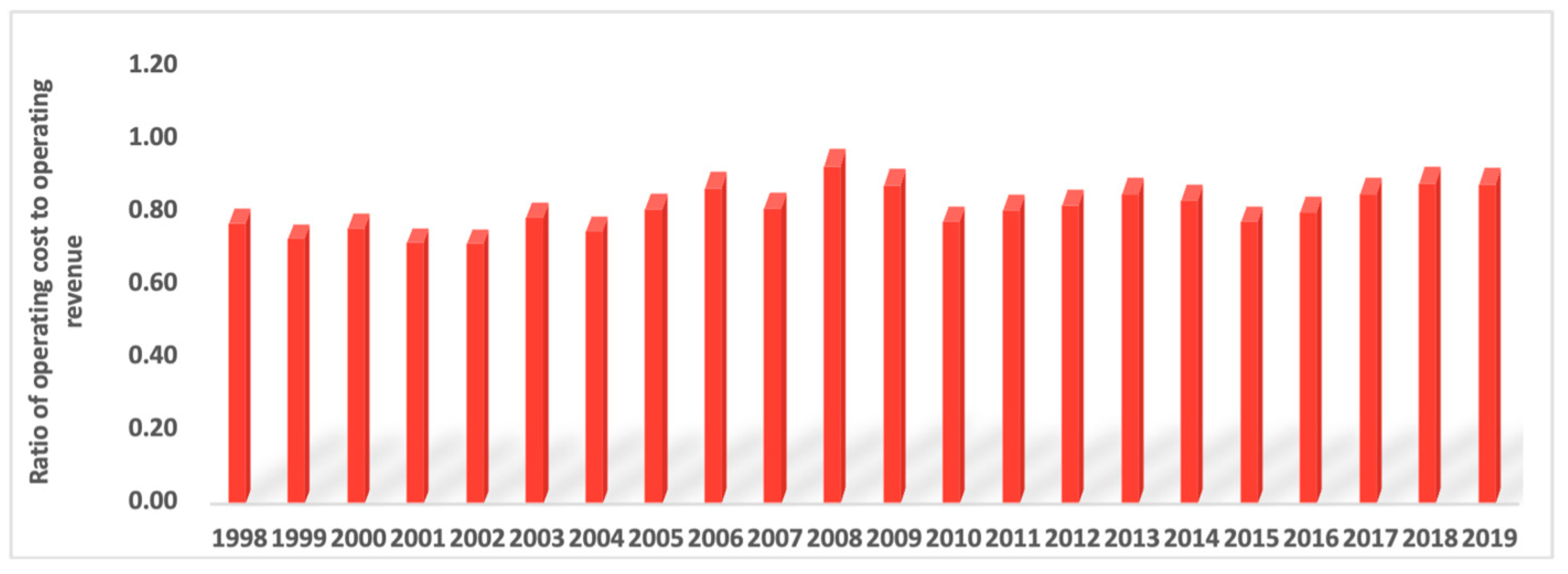
| Time Period | ||||||||
|---|---|---|---|---|---|---|---|---|
| 1998–1999 | −0.296 | 0.117 | −0.025 | 0.121 | 0.083 | −0.123 | −0.148 | −0.271 |
| 1999–2000 | 0.283 | 0.086 | 0.076 | 0.099 | 0.127 | −0.355 | 0.108 | 0.423 |
| 2000–2001 | −0.159 | 0.054 | −0.204 | 0.223 | 0.111 | −0.754 | −0.139 | −0.869 |
| 2001–2002 | −0.093 | 0.082 | −0.024 | 0.034 | 0.116 | −0.044 | −0.007 | 0.065 |
| 2002–2003 | −0.062 | 0.045 | −0.087 | 0.007 | −0.110 | 0.071 | 0.215 | 0.079 |
| 2003–2004 | −0.081 | 0.074 | 0.038 | −0.009 | 0.286 | −0.411 | −0.109 | −0.211 |
| 2004–2005 | −0.034 | 0.033 | −0.272 | −0.006 | 0.220 | −0.156 | 0.161 | −0.053 |
| 2005–2006 | −0.055 | 0.021 | −0.011 | 0.032 | −0.019 | −0.257 | 0.142 | −0.145 |
| 2006–2007 | −0.107 | 0.046 | 0.001 | 0.054 | −0.006 | 0.069 | −0.124 | −0.067 |
| 2007–2008 | 0.015 | −0.033 | −0.005 | −0.001 | −0.097 | −0.135 | 0.244 | −0.013 |
| 2008–2009 | −0.025 | 0.032 | 0.009 | −0.074 | 0.046 | 0.303 | −0.114 | 0.179 |
| 2009–2010 | −0.146 | 0.117 | −0.004 | 0.123 | −0.029 | −0.194 | −0.218 | −0.350 |
| 2010–2011 | 0.004 | 0.009 | 0.005 | −0.004 | −0.056 | −0.170 | 0.059 | −0.155 |
| 2011–2012 | 0.041 | −0.030 | −0.002 | −0.019 | −0.011 | 0.019 | 0.026 | 0.024 |
| 2012–2013 | 0.026 | 0.037 | −0.053 | 0.007 | 0.003 | 0.089 | 0.064 | 0.171 |
| 2013–2014 | −0.007 | −0.007 | 0.021 | 0.022 | −0.021 | 0.077 | −0.039 | 0.044 |
| 2014–2015 | −0.013 | 0.008 | 0.040 | 0.054 | −0.069 | 0.261 | −0.134 | 0.148 |
| 2015–2016 | −0.011 | 0.014 | 0.020 | 0.034 | −0.038 | 0.015 | 0.067 | 0.100 |
| 2016–2017 | 0.004 | 0.022 | 0.010 | 0.008 | −0.026 | −0.153 | 0.119 | −0.015 |
| 2017–2018 | −0.040 | −0.008 | 0.053 | 0.022 | −0.050 | −0.120 | 0.067 | −0.076 |
| 2018–2019 | −0.012 | −0.043 | 0.068 | 0.000 | 0.016 | −0.010 | −0.007 | 0.013 |
| Time Period | |||||||
|---|---|---|---|---|---|---|---|
| 1999–2004 | 30.9% | −65.2% | 38.5% | −62.4% | −101.9% | 272.1% | −12.1% |
| 2004–2009 | 216.0% | −101.1% | 273.9% | −7.0% | −131.8% | 170.5% | −320.4% |
| 2009–2014 | 27.2% | −48.3% | 15.5% | −49.1% | 48.9% | 71.6% | 34.3% |
| 2014–2019 | −41.3% | −4.6% | 109.4% | 68.6% | −96.2% | 7.5% | 56.6% |
| Average | 58.20% | −54.80% | 109.33% | −12.48% | −70.25% | 130.43% | −60.40% |
Disclaimer/Publisher’s Note: The statements, opinions and data contained in all publications are solely those of the individual author(s) and contributor(s) and not of MDPI and/or the editor(s). MDPI and/or the editor(s) disclaim responsibility for any injury to people or property resulting from any ideas, methods, instructions or products referred to in the content. |
© 2024 by the authors. Licensee MDPI, Basel, Switzerland. This article is an open access article distributed under the terms and conditions of the Creative Commons Attribution (CC BY) license (https://creativecommons.org/licenses/by/4.0/).
Share and Cite
Yu, J.; Lu, M.; Wang, K.; Ge, J.; Tao, Z.; Xu, Z.; Chen, L. Decomposing Carbon Intensity Trends in China’s Civil Aviation: A Comprehensive Analysis from 1998 to 2019. Aerospace 2024, 11, 480. https://doi.org/10.3390/aerospace11060480
Yu J, Lu M, Wang K, Ge J, Tao Z, Xu Z, Chen L. Decomposing Carbon Intensity Trends in China’s Civil Aviation: A Comprehensive Analysis from 1998 to 2019. Aerospace. 2024; 11(6):480. https://doi.org/10.3390/aerospace11060480
Chicago/Turabian StyleYu, Jinglei, Mengyuan Lu, Kaifeng Wang, Jinmei Ge, Zan Tao, Zheng Xu, and Longfei Chen. 2024. "Decomposing Carbon Intensity Trends in China’s Civil Aviation: A Comprehensive Analysis from 1998 to 2019" Aerospace 11, no. 6: 480. https://doi.org/10.3390/aerospace11060480





